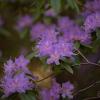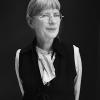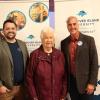March 12, 2009 - 9:39am
When Visual Arts professor Gregory Ball visited Haida Gwaii with his 79-year-old father, he never expected to be returning a year later to display his artwork in a prestigious First Nations museum.
Ball has been selected to display 12 original drawings during a solo exhibition at the Haida Gwaii Museum at Kay’llnagaay April 17 to May 23. (formerly the Queen Charlotte Islands)
“This is a dream come true,” said Ball, who teaches at Vancouver Island University. “I am really excited.”
Last spring, the Haida Gwaii Museum invited artists to submit exhibition proposals for the spring and fall of 2009. Ball was selected by a juried committee to exhibit graphite drawings from his series called "Transfigurations of the West Coast landscape.”
Ball developed the work over two years after being inspired by the trip to Haida Gwaii with his father.
“When I returned, I went back into my studio and documented some of the things I had seen in Haida Gwaii,” explained Ball. “I had noticed quite a lot of clear cutting. So I documented some of physical remnants found on sites extricated by logging in order to explore the persistent modern project of development and destruction that lies at the core of our ideas about the natural environment.”
The resulting drawings depict the landscapes, flora and fauna of British Columbia “in an ephemeral, disquieting manner,” said Ball.
In his drawings, solitary trees materialize out of minimized landscapes. The trees act as both a metaphor for the human form and a statement about the reduction of the natural environment.
“My process includes stenciling and blocking out areas of the paper with a fine dust of powdered graphite,” explained Ball. “The subjects in these drawings emerge from the background on which they have been placed and create deep pictorial space. They are frail and enduring, and are set against an increasingly desolate horizon, which makes their relationship to limbs and their human-like stature more apparent. There is a compelling sense of impermanence and a perpetual process of decay evoked in these works, which parallels both natural and unnatural cycles in the Queen Charlotte Islands.”
Nathalie Macfarlane, museum director, said the museum’s visual arts committeeselected Ball’s proposal based on the relevancy of his artist statement to Haida Gwaii, the originality of his artistic process and his professional qualifications.
“The museum houses a very fine showcase of First Nations work so I am really honored at having been selected,” added Ball, who also serves as Co-chair of Department of Art and Design and Chair of the Visual Art Department at VIU.
For Ball, the exhibition is an opportunity to display his work in a location significant to its creation and concept.
But he expects his return visit to Haida Gwaii will be even more meaningful. While visiting the community, he will make a presentation at the opening night of his exhibition, but also hopes to “engage in conversations with the local community that inspired the work and the people that are affected directly by the social, political, environmental and cultural issues that arise from the themes presented in my work.”
“To me, this trip to Haida Gwaii is about more than an art exhibition,” he said. “I see it as a wonderful opportunity to make connections with the people in Haida Gwaii and forge a deeper and more meaningful understanding of their culture and their people.”
The Haida Gwaii Museum is dedicated to conserving and making accessible the human and natural history of Haida Gwaii through exhibitions, research and public programs. The museum’s primary goal is to accommodate a presentation of Haida culture that represents the full range and quality of Haida art and artifacts.
The $26 million centre is a series of longhouses connected by interior walkways and fronted with six traditional totem poles representing each of the 14 clans. The feeling is of a traditional Haida seaside village, and a celebration of the living culture of the Haida people. Thousands of visitors from around the world have enjoyed visiting this new facility and its programs, in the beautiful natural setting that is Haida Gwaii.
Tags: In the Community






